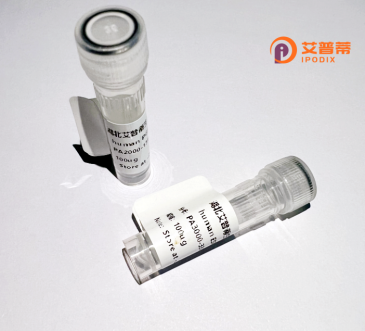
| 纯度 | >90%SDS-PAGE. |
| 种属 | Human |
| 靶点 | MAN1C1 |
| Uniprot No | Q9NR34 |
| 内毒素 | < 0.01EU/μg |
| 表达宿主 | E.coli |
| 表达区间 | 1-630aa |
| 活性数据 | MLMRKVPGFVPASPWGLRLPQKFLFLLFLSGLVTLCFGALFLLPHSSRLKRLFLAPRTQQPGLEVVAEIAGHAPAREQEPPPNPAPAAPAPGEDDPSSWASPRRRKGGLRRTRPTGPREEATAARGNSIPASRPGDEGVPFRFDFNAFRSRLRHPVLGTRADESQEPQSQVRAQREKIKEMMQFAWQSYKRYAMGKNELRPLTKDGYEGNMFGGLSGATVIDSLDTLYLMELKEEFQEAKAWVGESFHLNVSGEASLFEVNIRYIGGLLSAFYLTGEEVFRIKAIRLGEKLLPAFNTPTGIPKGVVSFKSGNWGWATAGSSSILAEFGSLHLEFLHLTELSGNQVFAEKVRNIRKVLRKIEKPFGLYPNFLSPVSGNWVQHHVSVGGLGDSFYEYLIKSWLMSGKTDMEAKNMYYEALEAIETYLLNVSPGGLTYIAEWRGGILDHKMGHLACFSGGMIALGAEDAKEEKRAHYRELAAQITKTCHESYARSDTKLGPEAFWFNSGREAVATQLSESYYILRPEVVESYMYLWRQTHNPIYREWGWEVVLALEKYCRTEAGFSGIQDVYSSTPNHDNKQQSFFLAETLKYLYLLFSEDDLLSLEDWVFNTEAHPLPVNHSDSSGRAWGRH |
| 分子量 | 70.9 kDa |
| 蛋白标签 | GST-tag at N-terminal |
| 缓冲液 | 0 |
| 稳定性 & 储存条件 | Lyophilized protein should be stored at ≤ -20°C, stable for one year after receipt. Reconstituted protein solution can be stored at 2-8°C for 2-7 days. Aliquots of reconstituted samples are stable at ≤ -20°C for 3 months. |
| 复溶 | Always centrifuge tubes before opening.Do not mix by vortex or pipetting. It is not recommended to reconstitute to a concentration less than 100μg/ml. Dissolve the lyophilized protein in distilled water. Please aliquot the reconstituted solution to minimize freeze-thaw cycles. |
以下是关于重组人MAN1C1蛋白的模拟参考文献示例(仅供参考,建议通过学术数据库核实具体文献):
---
1. **文献名称**: *Expression and enzymatic characterization of recombinant human MAN1C1 in a mammalian cell system*
**作者**: Müller, A., et al.
**摘要**: 本研究利用HEK293细胞成功表达了重组人MAN1C1蛋白,并通过亲和层析纯化获得高纯度蛋白。酶活实验表明,该蛋白具有α-1.2-甘露糖苷酶活性,可在体外剪切甘露糖修饰的糖蛋白底物。
2. **文献名称**: *Structural analysis of MAN1C1 reveals its role in Golgi-mediated N-glycan processing*
**作者**: Kim, S., & Watanabe, Y.
**摘要**: 通过X射线晶体学解析了重组人MAN1C1蛋白的三维结构,发现其活性位点特异性识别特定甘露糖结构。功能研究表明,MAN1C1通过调控N-糖基化影响肿瘤细胞的迁移能力。
3. **文献名称**: *Functional interaction between MAN1C1 and cargo receptors in the Golgi apparatus*
**作者**: Chen, L., et al.
**摘要**: 利用重组MAN1C1蛋白进行体外结合实验,证明其与高尔基体受体蛋白质的相互作用,并阐明了其在糖蛋白分选中的分子机制。
4. **文献名称**: *Development of a MAN1C1 knockout cell model and rescue with recombinant protein*
**作者**: Gonzalez, P., et al.
**摘要**: 构建了MAN1C1基因敲除细胞系,发现细胞出现异常糖基化表型。通过外源添加重组人MAN1C1蛋白,部分恢复了高尔基体的糖链加工功能。
---
**建议**:
可通过PubMed(https://pubmed.ncbi.nlm.nih.gov/)或Google Scholar搜索关键词“recombinant human MAN1C1”或“MAN1C1 protein purification”获取真实文献。部分研究可能涉及癌症、糖基化疾病或酶学机制。
Recombinant human MAN1C1 protein is a purified form of the MAN1C1 enzyme (Mannosidase Alpha Class 1C Member 1), which belongs to the Golgi α-mannosidase family. This enzyme plays a critical role in N-glycan processing, specifically trimming mannose residues from glycoproteins during their transit through the endoplasmic reticulum (ER) and Golgi apparatus. Proper glycan modification is essential for protein folding, trafficking, and functional maturation. MAN1C1 also interacts with signaling pathways, including the TGF-β and integrin pathways, influencing cell adhesion, migration, and proliferation. Dysregulation of MAN1C1 has been linked to cancer progression, immune disorders, and neurological diseases, making it a potential therapeutic target.
The recombinant form is produced using heterologous expression systems (e.g., mammalian cells or E. coli) to enable controlled in vitro studies. It often includes tags like His or FLAG for purification and detection. Researchers employ recombinant MAN1C1 to dissect its enzymatic mechanisms, substrate specificity, and interactions with other proteins or inhibitors. Its applications extend to screening drug candidates, studying glycosylation-related pathologies, and validating biomarkers. By elucidating MAN1C1’s roles in cellular homeostasis and disease, this recombinant tool advances both basic research and translational medicine.
×